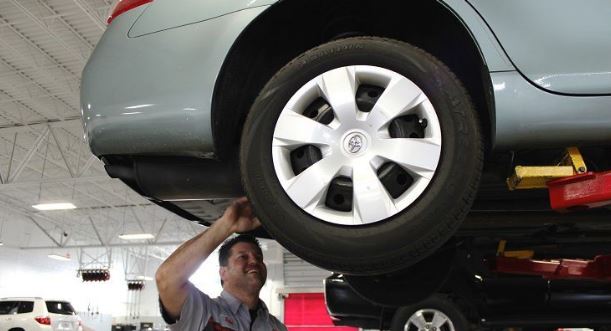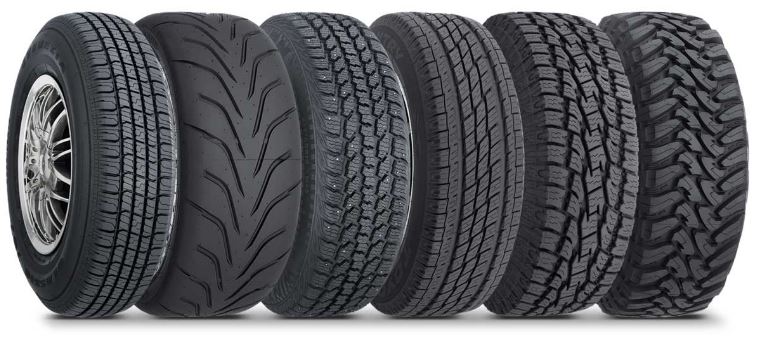The tires on your vehicle are the reason your vehicle can take you where you want to go. Without tires, everything from the engine to the turn signals serves little to no purpose. The type of tires you use, the size of tires you use, and how you maintain those tires will have a wide range of effects including how your car drives, and how much money you spend overall on maintenance.

While the science behind tires is complex, understanding them isn’t. Maintaining your tires properly also doesn’t take much effort, but it will play a dramatic role in how your vehicle performs. The experts at Giti Tire want to help you better understand why your tires are so important, and why all drivers need to pay more attention to their upkeep and condition of them. Let’s start with the basic.
Types of Car Tires
Tires are designed very specifically to meet certain needs for different types of vehicles. Each type of tire has its own purpose. Tires will differ in tread design and depth, construction, size, and chemical makeup of the rubber itself.
Some rubber is softer to increase traction, while some rubber is harder to prevent wear on hot and dry city streets. Often choosing tires is a process of finding the one that fits your needs best. The following is a list of the most common types of tires, and what characteristics make them different from the rest.

- All-season: All-season tires, just as the name implies, are designed to perform well all year long. These are particularly useful for drivers who live in areas with cold snowy winters, hot and dry summers, and a normal monsoon season. While all-season tires provide an overall great performance in moderate weather, they do not provide the same characteristics under more extreme conditions.
- Winter Tires: Winter tires are designed with specific rubber that stays softer when frozen. So that you get better traction on wet and icy roads. They tend to have a deeper tread with deeper channels to displace more water and larger pieces of snow. Winter tires also tend to have more aggressive edging, so that even the sides of the tires can grip and “bite” into the snow and ice.
- Off-road: Off-road tires tend to have large deeper and larger tread patterns than winter tires. They are designed to handle loose gravel, slick mud, and uneven surfaces. Mud tires tend to be larger, both in the diameter and width of the tread itself. Off-road tires can get even more specific, depending on where you plan on taking the vehicle, and what you plan on doing there. You may want specific mud tires, crawling tires designed for large rocks, or a wider tire that is designed to be deflated for sandy areas.
- All-terrain: Much like all-season tires, all-terrain tires are designed to do a little bit of everything. All-terrain tires handle moderate amounts of snow, gravel, mud, water, and sand. However, they may not provide the stopping power, traction, or handling that you need under more straining conditions. All-terrain tires hold up well on pavement, so they are great for those who use their vehicle for commuting, as well as weekend adventures.
- Specialty tires: There are many, many other types of tires in the world. Most of them are not designed for modern passenger cars and light-duty trucks, and so the common consumer doesn’t need to consider them. However, if you have specific needs that warrant investment in high-quality specialty tires, there are plenty of options to cater to your needs. Some of these include:
- Run flat tires- Run-flat tires can run on zero pressure for a limited amount of mileage at a limited speed so that a flat won’t stop you in your tracks
- Non-Pneumatic- Military-grade tires that do not require air pressure and can withstand incredible amounts of damage and stress.
- Efficiency tires- The newest trend of tires are eco-friendly tire options designed to last longer and get unmatched fuel efficiency.
See also: How tire pressure affects your vehicle’s characteristics!
How to Choose the Right Tires
Choosing the right tires when you are unprepared can be stressful and confusing. Know what to expect before you get there, and what types of tires that you will want to focus on. To help you determine what tires you should narrow in on, there are three things you will want to consider.

- Where you live: The area you live in is a key factor in the types of tires you will need. Hilly or mountainous areas tend to warrant tires with more traction for handling and stopping power. Areas that are flat can get away with slicker tires, as they are less worried about gravity’s forces acting against their tires. The area you live in will also dictate the climate that you need to be prepared for.
- What’s the weather: Hot and dry regions need hard rubber tires and don’t need much tread. Hot pavement will wear down tires faster, and the rubber needs to be more resistant. Colder and wetter climates tend to warrant thicker treads and tires that can stay softer in freezing temperatures. Areas that have a wide range of weather patterns and fully experience all four seasons benefit most from all-season and all-terrain tires.
- Budget and cost: Of course, the cost is typically a key factor. The higher quality of tires you look at purchasing, the more you will likely pay for them. However, you can typically expect more expensive tires to last longer and provide you with better performance. Anyone who doesn’t need a special type of tire or who is on a budget can find a quality selection of basic tires for a price that won’t break the bank.
- Rubber Compound: Make sure the tire is made up of high-quality rubber material. So that the traction and speed rating will be good. If the tire is made up of cheap rubber material then the traction will be less. The fuel cost will also reduce if you choose the right rubber compound.
Giti Tire offers a wide selection of tires of all types to 130 countries around the globe. As one of the world’s largest tire companies, Giti is dedicated to designing and producing exceptional tires for all types of vehicles and customer needs. Find a Giti dealer near you to find the right tire type and size to help you get the most out of every trip. Your safety, sanity, and bank account will thank you in the long run.
See also: What are the benefits of using Tires for Comfort and Noise?
We also remind you to take proper care of your tires year-round. Always keep tire pressures maintained, and make sure that you are rotating your tires correctly at least twice a year. Always replace your tires when they have worn down so that your safety is never compromised.



